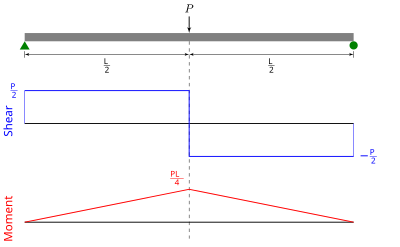
Back عزم انحناء Arabic Moment flector Catalan Ohybový moment Czech Авакан самант CV Biegemoment German Momento flector Spanish گشتاور خمشی Persian Taivutusmomentti Finnish מומנט כפיפה HE Momento flettente Italian

In solid mechanics, a bending moment is the reaction induced in a structural element when an external force or moment is applied to the element, causing the element to bend.[1][2] The most common or simplest structural element subjected to bending moments is the beam. The diagram shows a beam which is simply supported (free to rotate and therefore lacking bending moments) at both ends; the ends can only react to the shear loads. Other beams can have both ends fixed (known as encastre beam); therefore each end support has both bending moments and shear reaction loads. Beams can also have one end fixed and one end simply supported. The simplest type of beam is the cantilever, which is fixed at one end and is free at the other end (neither simple nor fixed). In reality, beam supports are usually neither absolutely fixed nor absolutely rotating freely.
The internal reaction loads in a cross-section of the structural element can be resolved into a resultant force and a resultant couple.[3] For equilibrium, the moment created by external forces/moments must be balanced by the couple induced by the internal loads. The resultant internal couple is called the bending moment while the resultant internal force is called the shear force (if it is transverse to the plane of element) or the normal force (if it is along the plane of the element). Normal force is also termed as axial force.
The bending moment at a section through a structural element may be defined as the sum of the moments about that section of all external forces acting to one side of that section. The forces and moments on either side of the section must be equal in order to counteract each other and maintain a state of equilibrium so the same bending moment will result from summing the moments, regardless of which side of the section is selected. If clockwise bending moments are taken as negative, then a negative bending moment within an element will cause "hogging", and a positive moment will cause "sagging". It is therefore clear that a point of zero bending moment within a beam is a point of contraflexure—that is, the point of transition from hogging to sagging or vice versa.
Moments and torques are measured as a force multiplied by a distance so they have as unit newton-metres (N·m), or pound-foot (lb·ft). The concept of bending moment is very important in engineering (particularly in civil and mechanical engineering) and physics.